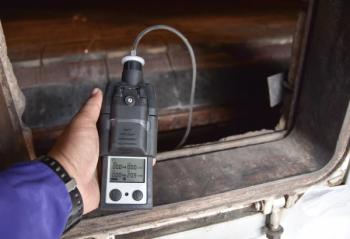
Best of the Week: Microplastic Pollution, Previewing the AAFS Conference, Next-Gen IR Sensors
Top articles published this week include an interview that provides insight into how marine monitoring can improve mitigation of plastic pollution, coverage of the American Academy of Forensic Sciences (AAFS) conference, and an article about next-generation infrared (IR) sensors.
This week, Spectroscopy published various articles that touch upon several important application areas such as environmental analysis, forensic analysis, and the semiconductor industry. Several key techniques are highlighted, including micro-Fourier transform infrared spectroscopy (μFT-IR), Raman spectroscopy, and infrared (IR) spectroscopy. Happy reading!
Although microplastic pollution has been investigated by many research teams, microplastic distribution in coastal marine environments remains poorly understood. A recent study attempted to bridge this knowledge gap. Samiksha Singh, who works at the Department of Environmental Sciences at the University of California, Riverside and the Gauteng City Region Observatory, in Johannesburg, South Africa, sat down with Spectroscopy to discuss her team’s findings and methodology (1). The methodology that Singh’s team used involved using pyrolysis gas chromatography–mass spectrometry (Py-GC–MS) to analyze tire and road particles and micro-Fourier transform infrared spectroscopy (μFT-IR) to process the particle spectra (1).
The American Academy of Forensic Sciences (AAFS) Conference in Baltimore highlights recent advancements in forensic analysis. Several sessions focus on attenuated total reflectance (ATR) Fourier transform infrared (FT-IR) spectroscopy and machine learning (ML) applications. A poster on February 19 explored forensic profiling of cigarette paper using ATR/FT-IR and ML, showing how spectral analysis can aid criminal investigations (2). On February 20, Akanksha Sharma presented a talk on sustainable wood sourcing and species identification via ATR/FT-IR and ML, aiding law enforcement in combating illegal logging (2). Another poster examined inorganic oxidizing salts in fireworks, enhancing forensic explosives analysis. A final poster explored ATR/FT-IR and ML for textile fiber identification, improving forensic workflows (2). These studies demonstrate how spectroscopy and ML enhance forensic evidence interpretation and crime-solving.
This week, the American Academy of Forensic Sciences (AAFS) Conference took place at the Baltimore Convention Center, in Baltimore, Maryland. At AAFS this year, much of the conversation centered around the application of artificial intelligence (AI) in forensic analysis, and where the advent of AI may take the industry in the future. In the keynote address, Michael Rogers, a well-known author, futurist, and journalist, delivered a talk on this subject (3).
The semiconductor industry is continuing to grow and take on increased importance in the international stage. Advances in spectroscopic instrumentation are playing a major role in propelling this industry forward. In a recent study, a team of researchers provides an in-depth overview of the latest advancements in infrared (IR) semiconductor sensor technology, highlighting new materials, enhanced detection capabilities, and expanding applications across industrial, medical, security, and environmental fields (4). The research explores how quantum dots, graphene, and novel nanomaterials are revolutionizing IR detection, paving the way for more efficient and versatile sensor systems (4).
Researchers from Southern Taiwan University of Science and Technology and National Cheng Kung University have demonstrated the potential of HgPSe3 thin flakes for UV-Vis photodetection. Their study, published in the Chinese Journal of Physics, highlights the material’s structural stability and optoelectronic properties (5). Using Raman spectroscopy helped confirm HgPSe3’s uniformity, while photodetectors fabricated with Ni/Au contacts exhibited low dark current and a spectral response from 400–630 nm (5). The devices showed fast response times (~28 ms) under 500 nm illumination, making them suitable for real-time applications like environmental monitoring and optical communication (5). Future research aims to optimize fabrication and explore integration with other 2D materials to enhance performance and expand detection capabilities.
References
- Wetzel, W. The State of Microplastic Pollution in the San Pedro Bay. Spectroscopy. Available at:
https://www.spectroscopyonline.com/view/the-state-of-microplastic-pollution-in-the-san-pedro-bay (accessed 2025-02-19). - Wetzel, W. Spotlighting Spectroscopy Innovations at the American Academy of Forensic Sciences Conference. Spectroscopy. Available at:
https://www.spectroscopyonline.com/view/spotlighting-spectroscopy-innovations-at-the-american-academy-of-forensic-sciences-conference (accessed 2025-02-19). - Wetzel, W. AAFS 2025: Previewing the Keynote Address. Spectroscopy. Available at:
https://www.spectroscopyonline.com/view/aafs-2025-previewing-the-keynote-address (accessed 2025-02-19). - Workman, Jr. J. Next-Generation Infrared Sensors: Innovations in Semiconductor Materials and Applications. Spectroscopy. Available at:
https://www.spectroscopyonline.com/view/next-generation-infrared-sensors-innovations-in-semiconductor-materials-and-applications (accessed 2025-02-19). - Workman, Jr., J. Raman Spectroscopy Reveals New 2D Semiconductor Material Showing Promise for UV-Visible Light Detection. Spectroscopy. Available at:
https://www.spectroscopyonline.com/view/raman-spectroscopy-reveals-new-2d-semiconductor-material-showing-promise-for-uv-visible-light-detection (accessed 2025-02-19).
Newsletter
Get essential updates on the latest spectroscopy technologies, regulatory standards, and best practices—subscribe today to Spectroscopy.





